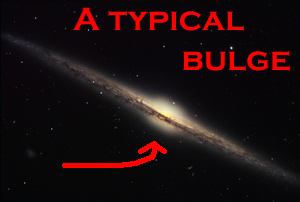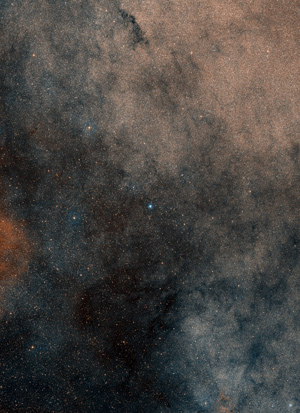 Why do spiral galaxies have central bulges?
Why do spiral galaxies have central bulges?
Some are bigger, some smaller, but pretty much every spiral galaxy we see has a roughly spherical puffy bulge of stars in its core (like in the edge-on spiral NGC 4565, shown here to the right). This downtown region of a galactic city is a bit mysterious. It contains old stars, very little gas, lots of dust… and we’re not sure how they form.
But a new observation of a cluster of stars in our Milky Way’s bulging center may have the key we’ve been looking for. Behold Terzan 5:
[Click to galactify, or grab the higher-res 1350 x 1370 version.]
Pretty, isn’t it? My first glance at this image made me think, “Oooh, sweet.” My second glance made me think “Hey, wait a sec…” and my third, after reading the scientific paper, made me smile. Terzan 5 is a pretty interesting place.
It’s just over 19,000 light years away, toward the galactic center. That area is lousy with thick patches of dust, making it very difficult to see anything, like trying to see a forest through a thick fog. These images were taken with the Very Large Telescope (srsly), an 8-meter goliath in Chile. The observations were done in the infrared, which can travel more easily through the thick dust – specifically at 1.2 and 2.2 microns (our eyes can see out to about 0.8 microns; anything longer than that is infrared). Amazingly, this image is a total of only four minutes of observations, two minutes in each filter! And while the size of the image is comfortably larger than the full Moon on the sky, the resolution is about 0.1 arcseconds, about that of Hubble! That’s why the second time I glanced at the image I was amazed; the star images are sharp and clear.
 Also, see how the stars appear to be redder on the left in the picture of the cluster above, and bluer on the right? That’s not because the stars themselves are different; it’s because the dust between us and the cluster is thicker on the left, making stars appear redder. The astronomers studying Terzan 5 had to account for that when they investigated the stars. The wide-field picture to the right shows you just how hard this can be; the center of our galaxy is a frakkin’ mess. You can see Terzan 5 in the center of this very wide image as the blue glow; everything else is stars and dust obscuring the view. I’ll add that this picture is pretty darn cool all by its lonesome, especially if you download the grossly embiggenated 240 Mb version.
Also, see how the stars appear to be redder on the left in the picture of the cluster above, and bluer on the right? That’s not because the stars themselves are different; it’s because the dust between us and the cluster is thicker on the left, making stars appear redder. The astronomers studying Terzan 5 had to account for that when they investigated the stars. The wide-field picture to the right shows you just how hard this can be; the center of our galaxy is a frakkin’ mess. You can see Terzan 5 in the center of this very wide image as the blue glow; everything else is stars and dust obscuring the view. I’ll add that this picture is pretty darn cool all by its lonesome, especially if you download the grossly embiggenated 240 Mb version.
Still, astronomers are clever, and were able to tease solid data out of the observations. And when they did get their results, they were surprised to see two different kinds of stars in the cluster. In the image, Terzan 5 appears to be a globular cluster: a spheroidal ball of stars held together by its own gravity. The Milky Way has well over a hundred globulars orbiting it. But usually, stars in globular clusters are all about the same age, indicating they were all formed at the same time. Terzan 5, however, appears to have two different populations of stars, one older than the other. Moreover, the younger ones appear to be more centrally concentrated in the cluster, with older stars farther out from the center.
That’s pretty weird. One possible way this could happen is if Terzan 5 isn’t really a globular cluster, which form from collapsing clouds of gas around the same time the Milky Way itself did. Maybe instead Terzan 5 is the remnant of a galaxy in and of itself, a small dwarf galaxy that got torn apart by our Milky Way’s gravity. Terzan 5 may have been a snack for our galaxy!
That would explain the two kinds of stars – galaxies, especially dwarfs, typically undergo different epochs of star formation – as well as their different positions inside the cluster. But the weird thing here is that the amount of iron in the stars matches the amount of iron in stars in the bulge of our galaxy. That’s an odd coincidence, if Terzan 5 formed separately from the Milky Way’s bulge.
But maybe, all together, this makes sense. Perhaps Terzan 5 really was once a dwarf galaxy. It fell in to the galactic center and got torn apart (we know that happens, and may explain how galaxies like the Milky Way grow to such large size). If that happens, the stars from the shredded dwarf 5 get tossed out, and become part of the Milky Way’s bulge, which puffs up due to the adding of these stars to its population. The remaining stars form the small ragtag spherical clump which we now see as Terzan 5.
If this is true, then it may be the key we need to understanding why spirals have bulges. They don’t necessarily form at the same time the galaxy itself does, but instead grow over time as the galaxy feeds on smaller, weaker galaxies. [Note that this is related to, but different from, a post I put up last week about globular clusters and galactic bulges.]
This type of galactic archaeology is amazing to me. We see what looks like one kind of object – a globular cluster – which upon closer examination (which itself was pretty tough to do) turns out to be perhaps a totally different kind of object – a half-digested galactic corpse – that itself became part of our own Milky Way, and by the way may also be the missing link we’ve been looking for between how spiral galaxies are born and how they form their central bulges.
All in all, not a bad piece of detective investigating! But of course, for astronomers, it’s all in a day’s night’s work.
Image credits: NGC 4565: Bruce Hugo and Leslie Gaul/Adam Block/NOAO/AURA/NSF; Terzan 5: ESO/F. Ferraro; Region around Terzan 5: ESO/Digitized Sky Survey 2.